39 способов создания бесплатного контента для вашего сайта
Вы ищите лучшие способы, с помощью которых вы могли бы создать бесплатный контент для вашего сайта? Тогда эта статья для Вас!
Очень важно регулярно публиковать контент в блоге. Но иногда очень сложно выделить время на создание высококачественного контента для вашего сайта. В этой статье мы составили список лучших инструментов, идей и ресурсов, которые вы можете использовать для создания бесплатного контента.
Думаю, этих пунктов достаточно, чтобы осветить этот вопрос. Но прежде чем мы продолжим, давайте определимся, что подразумевается под словами «бесплатный контент».
Что такое бесплатный контент?
 Бесплатный контент в этой статье будет означать контент, который вы можете использовать для своего блога. Это может быть текст, изображение, аудио или видео.
Бесплатный контент в этой статье будет означать контент, который вы можете использовать для своего блога. Это может быть текст, изображение, аудио или видео.
Данный контент не будет вам ничего стоить, ну или почти ничего. Единственное, что вам нужно вложить в это – время, если вы хотите получить результаты.
Где и когда использовать бесплатный контент для блога?
Прежде чем двигаться дальше, давайте разберемся, зачем нужен бесплатный контент.
Во-первых, вы должны спросить себя: для чего вы будете использовать бесплатный контент на сайте? Если вы хотите добавить его на сайт, то он должен выполнять второстепенную функцию и находится на страницах третьего уровня важности.
Уровни важности? Как правило, на сайте все страницы делятся на разные уровни важности.
Страницы первого уровня важности – это ваши первые и основные страницы. Это ваши высокоприоритетные страницы, которые приносят вам деньги конвертируя входящий трафик.
Далее идут страницы второго уровня важности. Они должны направлять собственный трафик на страницы первого уровня.
Наконец, существуют страницы третьего уровня. Их, как правило, больше всего по количеству, но просматривают их меньше всего. Они должны направлять свой трафик и делать отсылки к страницам первого и второго уровня важности.
Еще раз повторюсь, никогда не используйте бесплатный контент для страниц первого уровня. Бесплатный контент не является подробным, исчерпывающим и достаточно качественным, чтобы соответствовать стандартам страниц первого уровня важности. Размещения бесплатного контента на таких страницах нанесет вред вашему сайту. Давайте проясним эту ситуацию.
Если вам нужно разместить такую информацию, как описание обновлений компонентов на вашем устройстве, информацию о новой выпущенной продукции, ответы на часто задаваемые вопросы или комментарии к новым незначительным изменениям алгоритма Google, то следует разместить ее на страницах третьего уровня важности
Но если вам нужно повысить свой рейтинг среди конкурентов, и привлечь как можно больше потенциальных клиентов, которые потом принесут вам прибыль, вам нужно работать со страницами первого уровня. Для этого недостаточно нажать пару кнопок на клавиатуре и опубликовать бесплатную статью или попросить блогеров прислать вам бесплатный материал. Это так не работает.
Если вы посмотрите на качественный, конвертируемый контент, то увидите, что много времени тратиться на исследование проблемы, на подготовку, написание, редактирование и дизайн этого контента. Эти вещи требуют определенного времени и вам придется потрать на это свои ресурсы и средства.
Либо вы тратите свое время и прикладываете к этому усилия, либо нанимаете профессионалов, которые лично изучат ваши запросы, и создадут вам индивидуальный, более качественный стратегический контент, который действительно повлияет на ваш бизнес.
Но если вы просто ищете бесплатный контент для блога, которые расположите на страницах третьего уровня, наша статья сможет вам помочь.
Сервисы по созданию бесплатного контента для блога
Генераторы идей для заголовков статей
1. SEOPressor – плагин от WordPress, генерирующий заголовки блога. Просто введите свою тему или ключевые слова в утилиту и задайте тип описания вашего ключевого слова (это бренд / продукт? событие? лицо? и т. д.).
2. Hubspot Blog Topic Ideas Generator
Компания HubSpot является одними из первооткрывателей в сфере входящего маркетинга, также имеет собственный генератор идей для блога.
На этот раз вместо ключевых слов вам нужно ввести три разных существительных в соответствующее поле ввода. Затем генератор HubSpot создаст несколько идей для темы / названия вашей статьи.
На самом деле система генерирует весьма интересные идеи, при этом соблюдая требования к структуре заголовка.
Конечно, сервис не всегда справляется с задачей идеально. Используя автоматизированные инструменты, вам все равно придется просмотреть и скорректировать результаты, которые выдала программа.
Генераторы статей
Бесплатный сервис Free Article Spinner может создавать новый контент, начиная от предложений заканчивая целой статьей.
Ниже приведен примеры использования.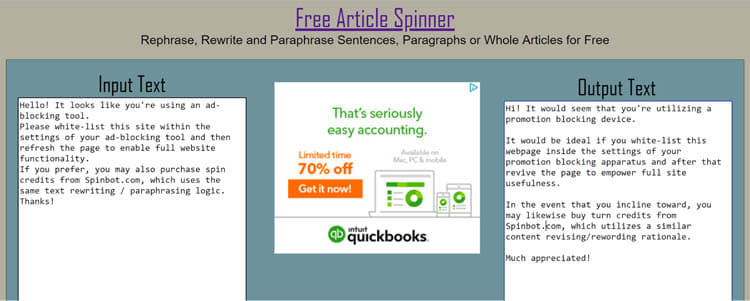
Конечный результат на самом деле выглядит забавным и почти непригодным для использования, поэтому вам потребуется примерно от 30 до 90 минут, чтобы отредактировать его и сделать конкурентоспособным.
Помните, что вам нужен бесплатный контент для блога, поэтому вы должны по максимуму использовать все ресурсы, которые у вас есть.
4. Article Rewriter
Article Rewriter создан организацией SEO Tools Centre. Сервис работает как обычный рерайтер статей. Все что нужно – нажать «spin», и инструмент сгенерирует различные варианты замены слов, чтобы текст стал уникальным.
Сервис подчеркивает часть слов, вам нужно просто нажать на них и выбрать синонимы к этим словам.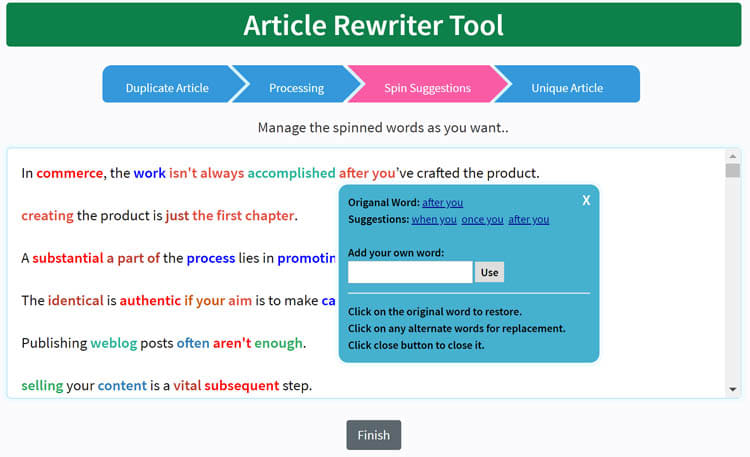
Этот сервис может помочь создать хорошо продуманные и уникальные статьи, если конечно у вас есть время чтобы заменять и редактировать часть слов. Вам ничего не нужно писать и придумывать, программа быстрая и совершенно бесплатная.
Бесплатные хранилища материалов и PLR статьи
Что такое хранилища материалов? В основном, это сайты где производятся миллионы статей. Некоторые из них можно использовать бесплатно, за часть из них нужно заплатить.
Что такое PLR статьи?
PLR означает права частной организации. Это особый вид лицензии, которая позволяет вам официально приобрести статью, а также редактировать ее и публиковать как свою собственную.
Тем не менее, приобретая такие статьи вы сталкиваетесь с рядом минусов. О них написал Джон Чоу в своем блоге.
«Существует огромная разница в качестве между статьями, написанными профессионалами, и теми, которые имеют частные права.
Еще одна вещь, о которой следует помнить, это то, что существуют спекулянты, которые перепродают свои статьи всем и каждому и возможно не одни раз. Это проблема дублирования контента, когда выясняется, что одна и та же статья «написана» разными людьми.
Поэтому имейте это в виду, прежде чем совершить такую покупку.
5. EzineArticles
EzineArticles является хранилищем контента, в котором материал можно выбирать по категориям. Весь контент написан профессиональными авторами.
Функция цитирования и публикации, которая расположена внизу материала, делает удобным ресурс EzineArticles так как позволяет открыть чистый текст и его html-копию, которую можно скопировать и вставить на ваш сайт.
Это все делается быстро, легко и бесплатно.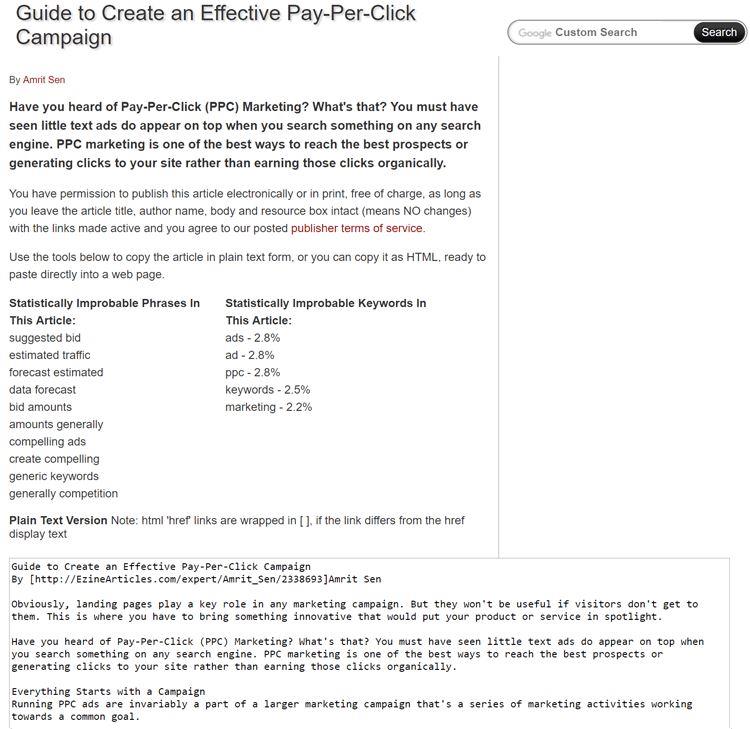
Обратите внимание, что тот материал, который вы получаете, возможно, не будет оригинальным. Другие издатели могут разместить один и тот же текст на своем сайте.
6. Articles.org (закрылся)
Еще один бесплатный онлайн-каталог статей, Articles.org в настоящее время содержит только около сотни статей в каждой из категорий.
Какие плюсы есть у этого ресурса? У них есть статьи на других языках, в том числе на русском!
7. Article Sphere (закрылся)
Владельцем ArticleSphere.com является сингапурский маркетинговый предприниматель Ларри Лима, данный ресурс является «онлайн-источником непрерывно пополняющегося качественного контента» и «бесплатным хранилищем статей» для тех, кто хочет использовать бесплатный контент на своих сайтах.
На ArticleSphere можно размещать статьи только на английском языке и, по сравнению с другими хранилищами, тут более строгие правила для авторов. Руководство сайта оставляют за собой право редактировать или удалять любые статьи, которые, по их мнению нуждаются в дополнении, и не соответствуют их редакционным правилам.
Чтобы использовать информацию в собственных целях, вам нужно нажать на кнопку «Republish».
Единственное, что может немного отвлекать на этом сайте, – это раздражающие объявления. Если вы не готовы довольно часто закрывать эти объявления – пропустите этот ресурс.
8. Amazines
На Amazines есть тысячи статей в их онлайн хранилище. Вы можете бесплатно смотреть и повторно публиковать любой контент на вашем сайте используя их оригинальные статьи.
Есть ли еще плюсы у этого ресурса? На Amazines также есть статьи на других языках.
9. Blogger Linkup
Вы можете подписаться на обновления ресурса BloggerLinkUp. Таким образом каждый понедельник, среду и пятницу вам будут приходить письма с новостям. В них будут перечислены блогеры, которые хотят продать свой контент, заказчики, а также представители PR сферы.
Когда вы увидите запрос, который вы можете удовлетворить, свяжитесь непосредственно с заказчиком.
Будьте готовы, что вы можете столкнуться с плохими работами и вам нужно будет их редактировать.
10. PostJoint
Post Joint – еще одно место, где вы можете найти бесплатный уникальный контент для своего блога. Ресурс Post Joint обеспечивает коммуникацию рекламодателей с владельцами сайтов. Post Joint облегчает процесс поиска информации и заботится о контроле качества.
В 2018 PostJoint больше не является бесплатным, но по-прежнему вы можете воспользоваться бесплатной пробной версией.
11. My Blog Guest
My Blog guest (MBG) – сообщество блогеров, которые готовы предоставить вам свой уникальный контент в обмен на то, что вы сошлетесь на него в своем блоге. Это сообщество принадлежит известному на западе блогеру Энн Смарти.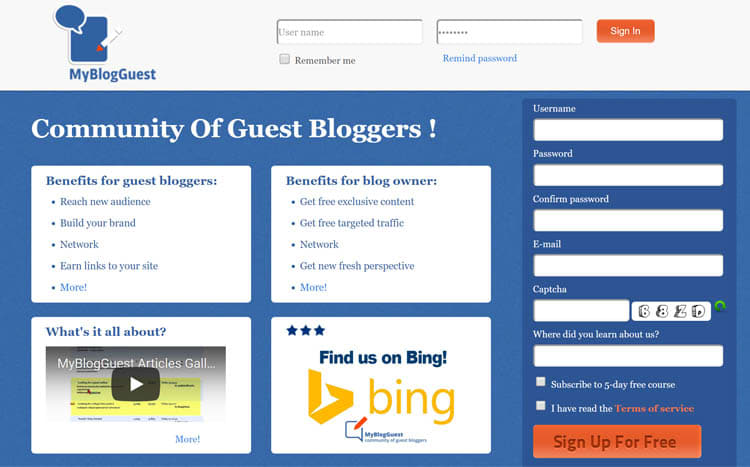
Этим ресурсом пользуется множество пользователей, и скорее всего вы найдете подходящую статью для вашего блога, независимо от его тематической ниши.
Ресурсы с бесплатным контентом
Wikimedia Commons – это сокровищница многоязычных медиа, которые вы можете бесплатно использовать.
Как и в Википедии, которая предоставляет некоммерческий, краудсорсинговый контент, весь контент в Викимедиа находится в свободном доступе для всех, кто хочет его использовать или же внести в него свой вклад.
13. Infogram
Если вы хотите добавить в свой блог более визуально привлекательный контент используя инфографику, диаграммы, карты, изображения из социальных сетей и т. д., Infogram – это то место, где вы сможете все это найти.
Зарегистрировавшись вы сможете получить доступ ко всему контенту, загрузить 10 изображений, создать 2 карты и 10 проектов.
Но если вы хотите загрузить еще больше изображений, то вам придется заплатить за это, выбрав на сайте подходящий для вас месячный тариф.
14. Pixabay (закрылся)
Если вы хотите найти и использовать бесплатные изображения, вектора, иллюстрации и видеоролики, то вам подойдет ресурс Pixabay. Вы можете редактировать и повторно использовать контент с этого сайта в коммерческих целях.
Фотографии красивы и качественны, трудно поверить в то, что они бесплатны.
Однако некоторые изображения публикуются с логотипом Shutterstock. Наличие логотипа платного сервиса Shutterstock вероятно является источником дохода сайта, поддерживая его на плаву.
15. The Noun Project
Noun project представляет собой ресурс, на котором можно найти более миллиона иконок, которые добавляют пользователи со всего мира.
Существует довольно большая библиотека бесплатных иконок. Но, конечно, если вы хотите большего, вы можете найти тематические наборы, которые вы можете купить в их магазине.
16. PhotoDropper (закрылся)
Если ваш сайт основан на платформе WordPress, вы также можете использовать плагин PhotoDropper, который помогает автоматически загружать бесплатные изображения в ваш блог.
PhotoDropper загружает миллионы креативных изображений с фотохостинга Flickr, кроме этого, разработчики работают над тем, чтобы плагин делал это и с других источников.
17. Web Archive
Web Archive или Wayback Machine – это онлайн-архив с огромным количеством разных медиа, которые можно повторно использовать в вашем блоге совершенно бесплатно.
Вы можете подумать, что в веб-архиве размещаются только старые файлы, но на самом деле это постоянно увеличивающееся онлайн-хранилище, в которое добавляется множество медиа-контента.
18. Atlas (закрылся)
Atlas – это бесплатный ресурс для визуализации данных. Он основан на платформе Quartz.
Повторное использование предоставленного контента ресурса Atlas в вашем блоге может стать хорошим способом повысить популярность вашего блога.
19. Canva
Возможно, это один из наиболее удобных в использовании инструментов графического дизайна. Canva – это отличный ресурс, если вам нужно создать уникальные изображения и визуализировать цитаты в вашем блоге.
Это бесплатный ресурс и вам нужно будет заплатить только в том случае, если вы захотите добавить функции и изображения, защищенные авторским правом.
20. Snappa
Если вам нужны более продвинутые функции в сфере графического дизайна, которыми могут пользоваться и непрофессиональные графические дизайнеры, то сервис Snappa – хороший выбор.
Вы можете делать пять бесплатных работ каждый месяц и добавлять персонализированную графику в свой блог.
21. Giphy
Если в вашем контенте использование мемов и гифок уместно и поможет немного развлечь пользователей, тогда бесплатный ресурс Giphy именно для вас.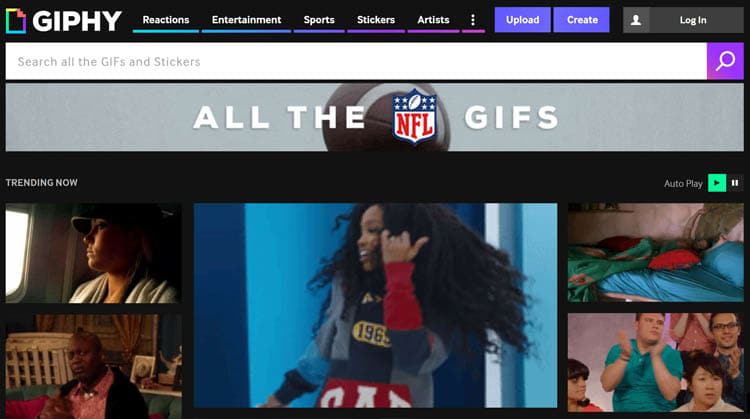
Вы даже можете загружать изображения и создавать свои собственные мемы совершенно бесплатно!
Больше идей для создания бесплатного контента вашего блога
22. NinjaOutreach
Guest posting – это прием, с которым вы уже наверняка знакомы. Суть в том, что автор предоставляет бесплатный контент, который будет опубликован на хорошем веб-сайте, в обмен на ссылку dofollow/nofollow или публикацию.
Поэтому, если вам нужен регулярный источник бесплатного контента для вашего сайта, вы должны открыть страницу «Написать для нас», что позволит блогерам узнать ваши требования, темы, которые вы затрагиваете, что они получат взамен и т.д.
Разумеется, для того, чтобы привлечь больше заинтересованных участников блога, вам сначала нужен хороший сайт без спама, с приличным показателем Domain Authority (DA). DA является расчетной метрикой, с помощью которой можно сравнить важность и мощность вашего сайта.
Убедитесь, что вы хорошо поработали над репутацией вашего сайта и Domain Authority.
Вы также можете самостоятельно обращаться к влиятельным блогерам у своей целевой аудитории.
23. Краудсорсинговые посты
Expert roundup posts (публикации с отзывами/мнениями нескольких экспертов) или Краудсорсинговые посты – это превосходный тройной контент-маркетинг: вы открываете возможность диалога с влиятельными людьми в своей нише, вы получаете бесплатный контент для блога и хорошие связи.
Большинство блогеров хотят участвовать в обзорах с участием экспертов, потому что это способствует их всеобщему признанию, благодаря обратным ссылкам. Все, что им нужно сделать, это дать вам несколько предложений бесплатного контента.
Для начала составьте список экспертов в вашей нише. Создайте форму для соцопроса со списком интересующих вас вопросов и отправьте ее своим предполагаемым кандидатам.
Для того, чтобы получить достаточное количество ответов, нужн отправить форму не менее чем 250-300 людям (если вы хотите получить как минимум 50 ответов).
Чем больше отзывов вы хотите, тем выше должно быть число потенциальных кандидатов.
После того, как вы начнете заливать ответы, следите за тем, чтобы они были тщательно отобраны. Добавьте вступительное предложение или даже абзац, если это требуется. Теперь вуаля, вы получаете совершенно новую статью для своего блога бесплатно.
24. Интервью
Вместо того чтобы тратить часы на исследования, а затем на сборку статьи, почему бы не взять интервью у специалиста в вашей нише?
25. Ньюсджекинг
Newsjacking – это когда вы переделываете наиболее важные новости в статью. Вроде бы ничего нового, но эта тактика заслуживает место в списке, так как другие блогеры часто забывают о ней.
Кроме того, когда вы создаете статьи, опираясь на тренды, то актуальность дискуссии, которые окружают эти новости, помогут продвинуть ваш контент намного быстрее, чем если бы вы писали об устаревших темах.
Например, вместо того, чтобы вручную исследовать и писать очень длинную статью о SEO, можно углубиться в самые свежие новости: последние рекомендации Google по оценке качества поиска.
Мгновенная статья!
В среднем, временные затраты около 2-4 часов!
Текст, составленный из основных ресурсов – просто части контента с других сайтов, которые позже объединяются.
Подобно публикациям с мнениями экспертов, они легко соединяются и высоко оцениваются аудиторией, потому что люди любят внушительные списки нужных им вещей!
26. ТОП-лист
Это похоже на предыдущий метод, за исключением того, что в этом случае мы объединяем блоги/сервисы/статьи и т.п.
Возьмем, к примеру, 30 программ и сервисов для раскрутки и продвижения в Инстаграм.
Вместо того, чтобы делать статью с нуля, получилось создать контент для блога, отобрав список рекомендуемых сервисов для продвижения в Instagram и добавив краткие описания для каждого, чтобы сориентировать наших читателей.
27. Изменение мультимедиа в текстовый контент
Изменение формата из мультимедиа в текст не является чем-то новым, но всё же этот пункт вошел в этот список именно потому, что он очень прост в применении и поэтому гениален.
Вы можете получить информацию из онлайн курсов, тренингов на Youtube или просто видеороликов. Затем вы можете разбить информацию по частям, и каждая из них станет основой для одной из ваших статей.
Предположим, что мы хотим написать статью о Google Adwords. Находим один из лучших курсов по этой теме. Проверяем программу обучения, и у вас есть мгновенное содержание статьи.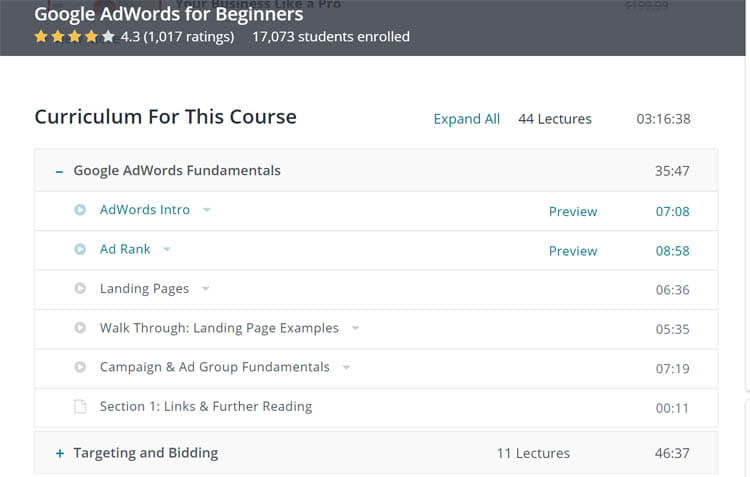
Если вы просматриваете бесплатный курс или что-то на Youtube, вы можете просто пропустить определенные части и настроить скорость воспроизведения так, чтобы вы успели собрать информацию из каждого фрагмента и далее поместить в свою статью.
28. Изменение старого контента
Другой способ получить больше бесплатного контента в блоге – это проанализировать уже опубликованные статьи и сократить те, которые слишком длинны или разделить информацию из них на две или более части, если они не связаны по смыслу.
Есть еще несколько способов, при помощи которых вы можете это сделать:
- Объедините старый контент по одной тематике для создания электронной книги.
- Сделайте инфографику из текста.
- Обновите старую статью и переопубликуйте ее.
29. Переделать неиспользуемый контент
Интернет представляет собой обширную свалку неработающих веб-сайтов, и здесь вы можете: собрать бесплатную информацию для вашего блога и опубликовать любой из так называемого «ничейного» контента на своем сайте.
Просто поищите старые сайты в своей нише. В этом вам также поможет Flippa.
Когда вы найдете что-нибудь хорошее, посмотрите, можете ли вы как-нибудь улучшить статью, а затем просто опубликуйте повторно.
Это вряд ли поможет SEO, но найдя хороший контент, вы можете привлечь своих читателей. Поэтому смело публикуйте контент повторно, и на всякий случай добавьте тег «Noindex».
30. Перевод контента на другие языки
Перевод популярного контента с вашего сайта на английский/другие языки может быть способом создания бесплатного контента. Поэтому проверьте данные Google Analytics и проанализируйте, есть ли у вас посетители из других стран.
Например, можно переводить Ваши статьи на другие языки и публиковать у себя на сайте, либо находить классные зарубежные статьи и переводить на русский.
31. Старательно подбирайте контент
Известно, что тщательно подобранный контент вызывает стремительное распространение среди пользователей.
«Лучшие статьи/видео/инфографика/статистика/ исследования с которыми вам стоит ознакомиться» обычно получают много трафика и взаимодействия с пользователями.
Бесплатные серверы для сбора контента
Ниже Вы увидите список из некоторых бесплатных сервисов для сбора данных (контента).
Примечание: не все они полностью бесплатны. Некоторые из них условно бесплатные, т.е. существует два варианта: премиум версия и бесплатная.
Все инструменты, которые вошли в этот список, имеют бесплатные версии, доступные для использования.
32. HARO
HARO – это сайт вопросов-ответов для журналистов и писателей, и вы можете получать здесь ответы на интересующие вас вопросы, то есть бесплатный контент для вашего блога.
Зарегистрируйтесь на сервисе и выберите интересующую вас категорию. Затем отправьте свои вопросы.
Они будут отправлены другим пользователям HARO, которые затем ответят на ваши вопросы и предоставят вам контент, который вы можете использовать в своей статье.
Список платных ресурсов
Вы можете совершенно бесплатно получить контент для своего блога, не так ли? И все же люди до сих пор платят за покупку статей для своего блога. Зачем?
Ниже Вы увидите примеры платных инструментов, которые демонстрируют почему, несмотря на наличие бесплатных серверов, большинство надежных компаний по-прежнему предпочитают вкладывать деньги в покупку контента.
33. Unique Article Creator
Unique article creator говорит о себе, как о многоязычном, SEO-дружественном генераторе контенте для блога.
Однако если вы хотите 100% уникальный контент, вам придется заплатить.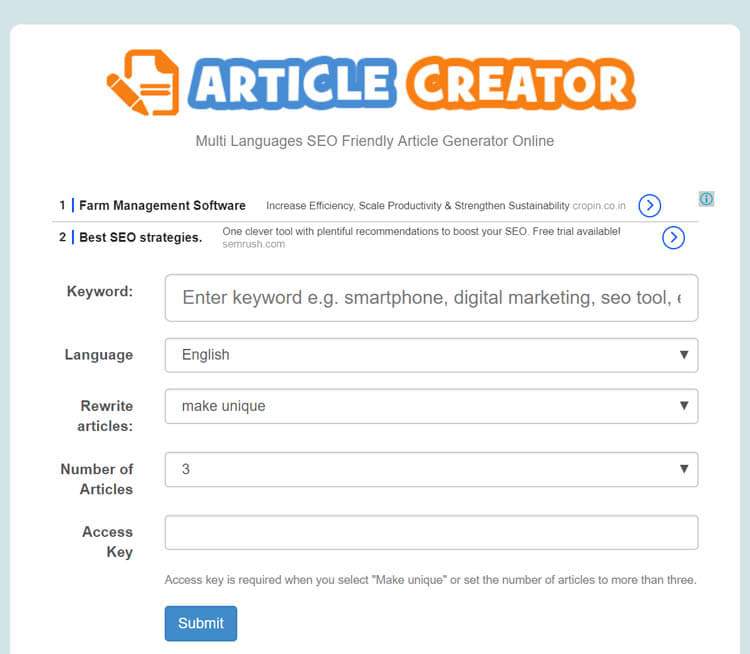
Услуга, включающая неограниченную переработку статей в месяц обойдется вам в 4 доллара. Опять же, качество этих статей оставляет желать лучшего, поэтому вам все равно придется их редактировать, чтобы сделать ваши посты уникальными и читаемыми.
34. Article Generator.org
Он работает также, как и Article Creator. Вам нужно ввести свое ключевое слово, и далее сервис подбирает контент в Интернете, и вы можете его использовать. Также, сервис может переписать этот контент для вас и сделать его уникальным.
Как и в прошлом случае, контент, полученный таким образом, обычно будет нуждаться в редактировании человеком, это поможет сделать текст читабельным и естественным.
Исправьте всё, что бросается в глаза с точки зрения грамматики, использования слов и стиля. Как только статьи станут читабельными и без плагиата, вы справились, все готово. Это должно занять от 30 до 120 минут.
35. ArticleForge
ArticleForge предполагает создание уникального контента на основе материала, собранного в Интернете. Вам опять нужно просто ввести ключевое слово и некоторые дополнительные ключевые слова по тематике, а затем нажать на кнопку «Создать новую статью».
К сожалению, даже после регистрации и оплаты расширенных услуг, все равно не вышло создать пригодную статью.
36. Articoolo
Articoolo – это сервис для создания статей и переработки текстов с системой оплаты по мере использования. Если вы зарегистрируетесь, то получите бесплатный кредит для тестирования сервиса.
Ниже пример использования бесплатной версии. Получится ли с помощью Articoolo создать статью о «бесплатном контенте для блога»?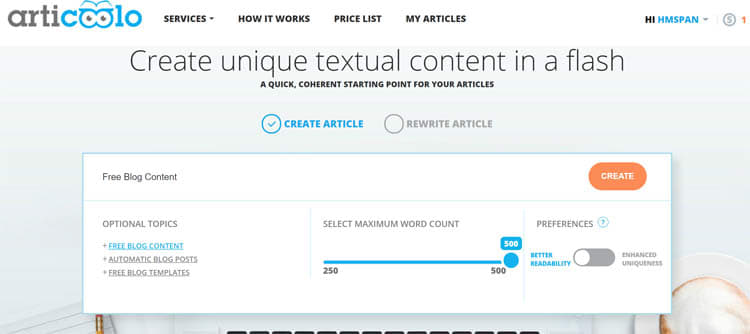
Вам нужно будет указать свои предпочтения, и помните, что количество слов ограничено – максимум 500.
Через несколько минут Вы получите бесплатную, автоматически сгенерированную статью.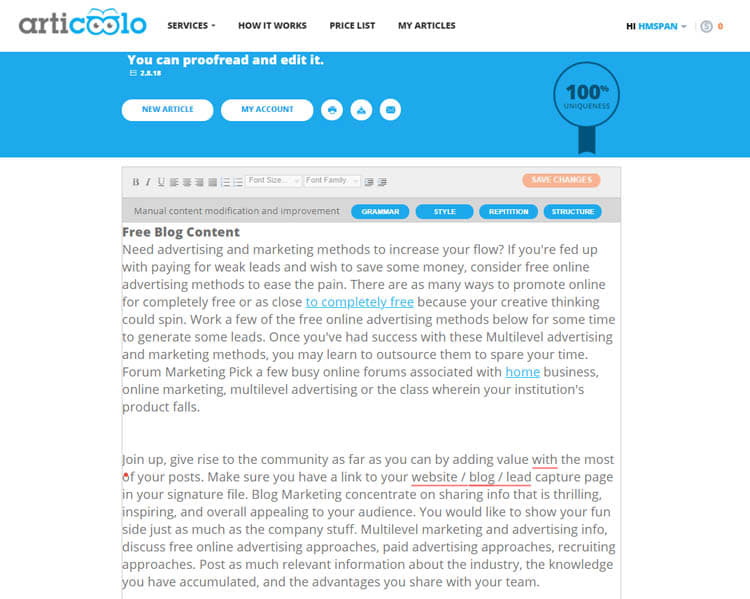
Если вы прочтете то, что вышло, убедитесь, что это действительно потрясающе. Текст вышел вполне содержательный. Тем не менее, он по-прежнему пропустил актуальную тему, о которой необходимо написать.
37. WordAI
Следующий пример – сервис WordAI. Разработчики представляют инструмент как генератор контента с искусственным интеллектом. Они также говорят, что текст, переписанный WordAI, обладает такой же читабельностью, как и текст, переписанный человеком. Так ли это на самом деле? Сейчас проверим.
Существует бесплатная трехдневная пробная версия, которую потом можно заменить на платную, стоимостью 49,95$ в месяц.
Также если вы использовали более 10000 слов, вы получаете дополнительные за 2 доллара.
Задайте свои настройки, затем просто нажмите «Сгенерировать сейчас».
Через некоторое время получаем три варианта. Первый из них «Super Unique Spin».
И два под названием «A Spin», один из которых вы можете увидеть и оценить ниже: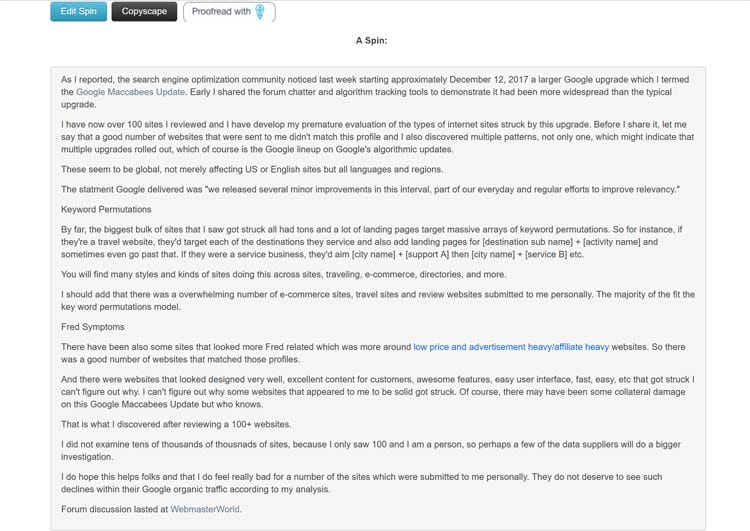
Он все еще непригоден для использования.
Тем не менее, результат определенно лучше по сравнению с первыми бесплатными генераторами статей, перечисленными в этой публикации, и отредактировать этот текст уже не составит особого труда.
38. Wordsmith
Если вы были разочарованы предыдущими сервисами для создания контента, то следующие в этом списке могут вас приятно удивить.
На самом деле есть гораздо более высокотехнологичные инструменты, которые создают почти такой же качественный контент, как тот, что написан человеком.
Эти инструменты способны обрабатывать данные, анализировать и публиковать контент гораздо быстрее, чем это смогла бы сделать команда людей. Они самые функциональные, но соответственно и самые дорогие в этом списке.
Один из таких инструментов – Wordsmith. Это продукт компании Automated Insights (AI), который она представляет как «платформу для создания естественного языка (natural language generation – NLG), способную превращать данные в содержательное повествование».
Если вы думаете, что это всего лишь маркетинговый ход, и что при тестировании сервиса мы получим такие же печальные результаты, как и у прошлых генераторов, то вы ошибаетесь.
Associated Press даже выпустили видео, в котором рассказали о том, что многие компании перешли на услуги таких инструментов, как Wordsmith. Теперь онлайн сервисы ведут отчеты, пишут статьи и сводки новостей и делают всё, что раньше делали люди.
Инструмент Quill, созданный компанией Narrative Science, является конкурентом Wordsmith.
Quill, как и Wordsmith, также работает по принципу NLG и, согласно описанию «преобразует данные в содержательный текст легкий для восприятия». Так что в принципе, они работают одинаково.
Как и его конкурент, Quill также имеет впечатляющую клиентуру из влиятельных организаций Wall Street, таких как Credit Suisse, Deloitte и MasterCard.
Ниже приведен пример публикации, созданной Quill.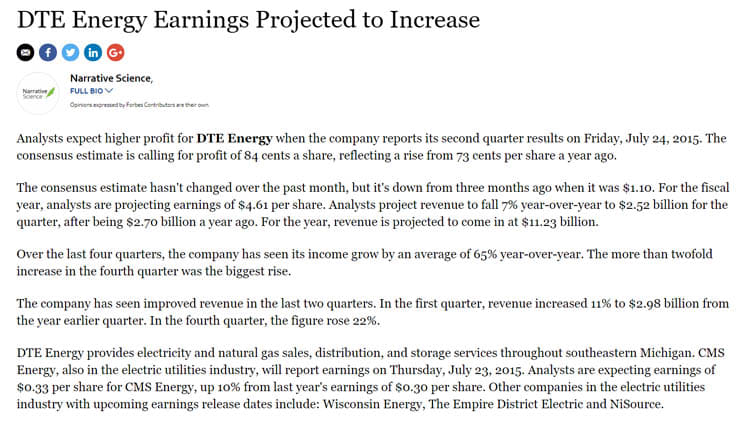
Впечатляюще, верно? К сожалению, все это очень дорого стоит.
Выводы
Итак, теперь вам известно достаточно много вариантов создания бесплатного контента для блога.
Главное помните, что бесплатный контент для блога работает, но стоит быть осторожнее, чтобы не испортить репутацию вашего сайта!
Вольный перевод с NinjaOutreach.
Эксперт в области интернет-маркетинга. Руководитель маркетингового агентства MAVR.
Бизнес-степень «Мастер делового администрирования» (MBA).


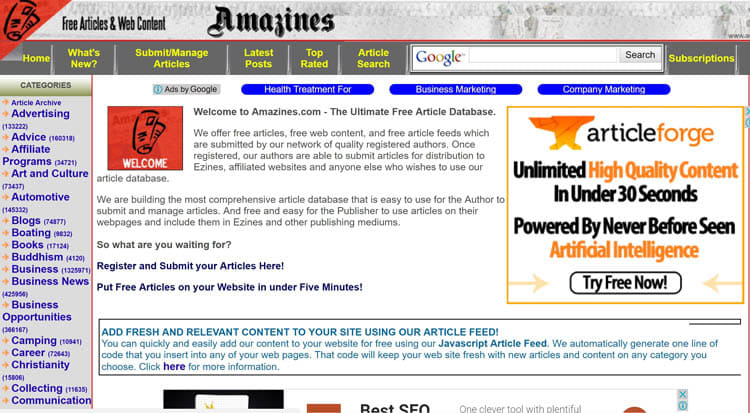

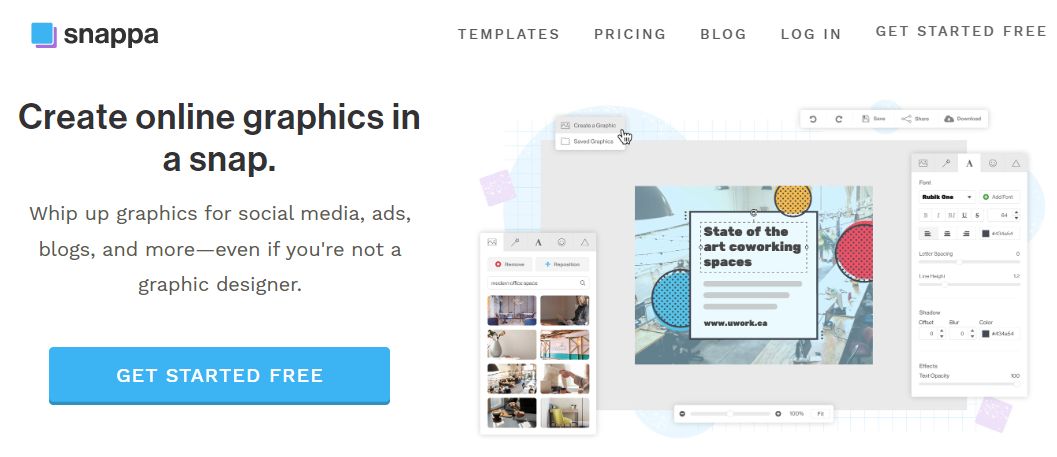
Заголовок кричащий ))
Все равно, чтобы совсем ничего не писать, не получится… На подкастах далеко не уедешь…